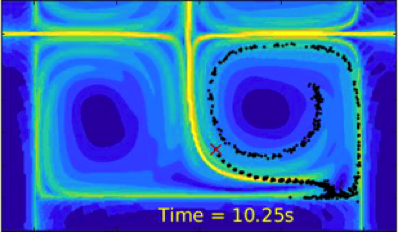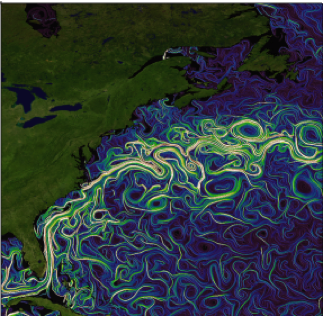Overview
In this collaborative project with the University of Pennsylvania, we are investigating how to coordinate active floaters with limited mobility and communication capacity, with more capable underwater or surface robotic vehicles, in order to establish a reconfigurable sensor network that exploits the physics of their ambient environment.
More than 70% of the Earth’s surface is covered in water. There is a great need to survey, monitor, and search over large swaths of ocean, either for monitor algae, measure water quality, or track the dissipation of pollutants. Miniature, inexpensive, semi-passive drifters can be deployed in numbers to form a large-scale sensor network over an aquatic environment for survey purposes, but in order to maximize their deployment time, given their limited resources, it makes sense to use the natural current and “ride” this flow as they make their way through the ocean. How the floaters can make the most use of this ambient resource and harvest this energy from their physical environment to perform their survey task is one big part of this collaborative research effort.
The realization of this spatially distributed sensor networ presents unique new research challenges in optimization, operational research, and cooperative control.
Outcomes
Publications resulting from work on this project:
Nonlinear synchronization control for short-range mobile sensors drifting in geophysical flows. In Proceedings of the IEEE International Conference on Robotics and Automation, 2020
Low-range interaction periodic rendezvous along Lagrangian coherent structures. In Proceedings of the IEEE American Control Conference, 2019 pages 4012-4017.
Synchronous Rendezvous for Networks of Active Drifters in Gyre Flows. In N. Correll, M. Schwager and M. Otte (eds) Proceedings of the 2018 International Symposium on Distributed Autonomous Robotic Systems, pages 413-425, Springer, 2019.
Synchronous Rendezvous for Networks of Marine Robots in Large Scale Ocean Monitoring. Frontiers in Robotics and AI, 6:76, 2019.
Synchronous Rendezvous for Periodically Orbiting Vehicles with Very-Low-Range Interactions. In Proceedings of the IEEE American Control Conference, pages 1641–1646, 2018.
Exploiting Stochasticity for the Control of Transitions in Gyre Flows, In Robotics: Science and Systems, 2018.
Synchronous Rendezvous for Periodically Orbiting Vehicles with Very-Low-Range Interactions, In IEEE American Control Conference, 2018.
Funding Organization: ONR
Duration: 3 years
Budget (UD portion): $300,000
Participants: PENN, UD


